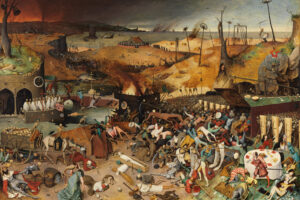
February 22, 2021
Soleil Ô and a Transnational Third Cinema
This text is presented as part of the Mizna Film Series, a monthly selection which expands our regular film programming to include screenings, critical essays, filmmaker interviews, and discussions exploring revolutionary forms of cinema from the SWANA region and beyond.
Soleil Ô and a Transnational Third Cinema
In the wake of a tricontinental wave of revolutions and independence movements in Latin America, Africa, and Asia, the theoretical and ideological framework of Third Cinema came to life through a series of militant manifestos by Latin American filmmakers Fernando Solanas, Octavio Getino, and Julio García Espinosa in the late 1960s. Solanas and Getino’s essay “Towards a Third Cinema,” published in 1969, coined the term “Third Cinema” in the journal Tricontinental by the Organization of Solidarity with the People of Asia, Africa and Latin America (OSPAAAL). While concerned with the national process of decolonization in Third Cinema, Solanas and Getino left out the transnational question when it comes to the political. The work of Teshome Gabriel around the rethinking of Third Cinema, and especially in his book Third Cinema in The Third World: The Aesthetics of Liberation, expands Third Cinema theory into the transnational. Gabriel highlights that Third Cinema is not a cinema defined by geography; it is a cinema primarily defined by its socialist, and therefore transnational, politics.2 At large, Third Cinema theory and practice offered a move against and away from consumer capitalism and Hollywood’s First Cinema. Med Hondo’s Soleil Ô (1970) in particular embodies this Third Cinema rejection of Eurocentrism and First and Second Cinema conventions both thematically and stylistically, and through a transnational lens, the film moves beyond the national question of liberation.
Early Third Cinema theory and practice were powerfully marked by the larger critical paradigms of dependency theory and notions around cultural imperialism dominant in the 1960s and 1970s.3 The journal Tricontinental expressed the aspirations of peoples from three continents struggling against the criminal policies of intervention, plunder, and aggression employed by the world-wide imperialist system and particularly by US Imperialism against the Afro-Asian-Latin American peoples. The first issue of the journal included articles by Franz Fanon, Kim Il Sung, and Fidel Castro.4 Similarly, Third Cinema aimed to immerse itself in the lives and struggles of the peoples of the Third World. Since the Third World should not continue to dissipate its culture and national identity, Third Cinema tries to conserve what is left.5 The ideology of Third Cinema thus adheres to investigating the traumatic cultural shifts that engulf the peoples of Africa, Asia, and Latin America as a result of colonization.
Focused on an unnamed Black African migrant with an unclear nationality, Soleil Ô narrates the migration of Africans to France during the 1950s and 1960s, a period derogatorily termed the “black invasion” by the French. At that point in history, the mass migration of immigrants from a colonial empire in the process of dissolution was replacing the European migrant labor force France depended upon. Thus, tensions arose as the influx of new migrants and influences from African colonies was transforming the structure of the French society. Paradoxically, this transformation in French society simultaneously resulted in an entrenchment of colonial power disparities, which reinforced patterns of systemic oppression initiated under colonial rule in a neocolonial light. These attitudes were reflected through the exploitation of Black African migrants who, regardless of education and skill levels, were relegated to the lowest ranks of employment as laborers. Denied adequate housing and subjected to extreme racism, these migrants found themselves trapped between a Parisian bureaucracy that resented their presence and dysfunctional post-independence African governments who regarded their situation as a French problem. Soleil Ô‘s depiction of the Black migrant as persona non grata in both France and a (post-)colonial Africa creates a dislocation that allows Hondo to advocate the evolution of revolutionary ideology and its potential role in transforming both Africa and the situation for Black migrants in Paris.6
Third Cinema filmmakers see film as a weapon with the camera as an “inexhaustible expropriator of image-weapons and the projector, a gun that can shoot 24 frames per second.”7 The act of filming then becomes more than a political act. Third Cinema films do not aim to re-aestheticize traditional cinematic modes, but to rather politicize cinema to the extent where a new cinematic code appropriate to its needs is established.8 While mainstream First Cinema entertains, it retains a huge emphasis on individual psychology, personal achievement, and wealth accumulation. Set against an often hostile world, Third Cinema emphasizes social problems and collective actions, confronting issues such as social justice, racial and gender equality, and the spreading of wealth and power. Third Cinema has a direct political function in that it attacks the hegemonic culture. Just as Hollywood cinema is political and one-sided, so is Third Cinema, except that its political ideology is opposed to the political views implicit in Hollywood cinema.9 Third Cinema includes an infinite variety of subjects and forms, as varied as the lives of the people it portrays, identifying the masses as the true hero and the only existing force capable of defeating class enemies in their home fronts.10 The production and praxis of Third Cinema, i.e. the call to action of these films, leads us to view the aesthetic of Third Cinema as a form of ideology; that is, the films point toward a confrontational cinema and an aesthetics of liberation.11 It can even be argued that a film’s validity as a revolutionary film resides in its cultural intonations, historical context, and ideological dimensions.12
Stylistically, Third Cinema achieves this confrontational effect by relying on several cinematic choices that challenge the conventional choices of First Cinema. Most notably, Third Cinema films often combine the fictional and the documentary to deliver a confrontational ideology rooted in reality. For Third Cinema, style, form, and ideology all become inseparable. The essence of Third Cinema is found in its rejection of First Cinema and cultural imperialism. Thus, the ideology and form of Third Cinema is to deconstruct the colonial culture permeating Third World nations. Third Cinema counters the images of Third World peoples portrayed as uncivilized, violent, and primitive and confronts the true violence and incivility practiced by the colonial First World.13 Throughout Soleil Ô, Hondo violently attacks the mirages and effects of colonialism on humans within a Marxist framework. In one scene, the unnamed African migrant enters an open apartment to ask for assistance in finding a job. He finds a man and a woman each staring at a different television, their eyes glued to variety shows playing on screen, taking no notice of their surroundings nor the nameless protagonist asking for help. This scene portrays the white French couple as brainwashed slaves to on-screen capitalism. The couple suddenly starts having an intense fight about money, and their uncivil screams grow louder and louder. Their screams sound almost like animals howling at each other and the camera moves violently between their faces as they exchange yells. The couple is portrayed in a way similar to how First World cultural products portray Third World peoples as loud, violent, and uncivilized. In a comic change of events, the couple’s fight comes to an abrupt end as soon as a Christian sermon comes up on their TV screens. With satire, Hondo attacks common First World stereotypes, humorously presenting a White-passing West Indian who has “transmitted Blackness” to his baby. In another scene, Hondo shows a disappointed White French woman unimpressed with the sexual performance of her Black African date, addressing the hypersexualized stereotype of Black men that still pervades many White minds.14
The point of view in Third Cinema is not a reflection of the consciousness or subjectivity of a single subject (a protagonist/hero); rather, the central figure in Third Cinema serves to develop a historical perspective on radical social change. The protagonist/hero might cast the glance, but in actuality it is the masses or the people who give substance to the gaze.15 The individual hero in Third Cinema is a collective subject; they are not endowed with individuality—the legitimizing function of conventional cinema.16 Correspondingly, the unnamed protagonist in Soleil Ô represents African immigrants in Europe in large, his bag has the flags of several African states on it and it is never clear where he is from. Gabriel highlights that where a central character is used, the viewpoint goes beyond that of the individual to develop a sense of the relationship between the individual and the community, of the collective, and of history.17 The lack of name or nationality of the protagonist works to adhere to a transnational framework in critiquing neo-colonial European exploitation of Black African migrant workers.
Additionally, Third Cinema films often contain critiques of religion functioning as a vital aid in the destruction of identity of colonized African peoples. The opening prologue of the film documents the breakdown of individual African nations by the denial of their languages, religions, and cultures. Hondo presents this denial through the visual metaphor of a Christian baptism conducted by a White priest and attended by a culturally diverse group of African men. As each man approaches the priest, he asks him in French to be forgiven for speaking his indigenous language: Peul, Bambara, Lingala, Creole, and several others. In effect, all of these individual cultures become reduced to one by the acceptance of the colonizer’s language and the rejection of their own. Thus as the priest exhorts the spirit of evil to “leave these children,” the African men become dislocated from a multiplicity of indigenous origins and begin a process of assimilation that falsely promises to lead them to cultural union with the colonizer.18 As each man is baptized, they assume a new Christian name given by the priest. Their individual identities and nations are erased through the enforcement of a new identity on them by the colonizer, here represented by the priest.
The last sequence of Soleil Ô shows the nameless protagonist in a forest. He is invited to eat with a French family vacationing at their country house, but is shocked by their waste, which the film extends to represent the waste of the First World. In a very uncivil manner, the children are allowed, or rather encouraged, by their parents to step on all the food on the lunch table. Disgusted by such insensitive and vile acts so strongly opposed to his own ideals, the nameless protagonist walks away, leaving the family, and quickly starts running back into the forest. Breathless, he falls at the trunk of a tree and has visions of Third World revolutionaries such as Patrice Lumumba, Che Guevara, Mehdi Ben Barka, and Malcolm X. Such an ending reflects the ideological progress which has taken place in the nameless protagonist’s mind. It symbolizes his new awareness, which parallels his own escape. He is surrounded by images of prominent transnational figures fighting against colonialism, a fight that has existed since the very beginning of White imperialism in Africa and that is seldom mentioned by mainstream First World media and cultural products.19 His fight for liberation is in line with the fight of the revolutionary figures he sees in the forest; his fight is not individual, it is a collective fight against colonialism, exploitation, and the erasure of the multiplicity of identity.
Third Cinema is a cinema of subversion. It aims to simultaneously destroy and construct: there is a destruction of the images of colonial or neo-colonial cinema, and a construction of another cinema that captures the transnational revolutionary impulse of the peoples of the Third World.20 The transnational visions of Africa created by diaspora, such as Soleil Ô, challenge depictions of Africa as a monolithic site of origin and authenticity. In The Archeology of Origin: Transnational Visions of Africa in a Borderless Cinema, Sheila Petty outlines Avtar Brah’s concept of diaspora as a delineation of a field of identifications, where imagined communities are forged within and outside a confluence of narratives from annals of collective memory and rememory.21 This idea suggests that diaspora, as both an abstraction and a reality, defies borders of nation and is a space where multiple subject positions are juxtaposed, contested, proclaimed, or disavowed. Thus, histories and cultures intercross freely, creating transnational layers of identity and of origin. As a diasporic film, Med Hondo’s Soleil Ô provides a transnational confrontation to neo-colonial exploitation of Black African migrant workers in France in line with the style and ideology of Third Cinema.
1 Solanas, Fernando, and Octavio Getino. “TOWARD A THIRD CINEMA.” Cinéaste, vol. 4, no. 3, 1970, pp. 1–10. JSTOR, www.jstor.org/stable/41685716, 3.
2 Wayne, Mike. Political Film: The Dialectics of Third Cinema. Pluto Press, 2001, 1.
3 Stam, Robert. “Eurocentrism, Afrocentrism, Polycentrism: Theories of Third Cinema.” Quarterly Review of Film and Video, vol. 13, no. 1-3, Jan. 1991, pp. 217–237., doi:10.1080/10509209109361378, 219.
4 Buchsbaum, Jonathan. “A Closer Look at Third Cinema.” Historical Journal of Film, Radio and Television, vol. 21, no. 2, June 2001, pp. 153–166., doi:10.1080/01439680120051497, 155.
5 Gabriel, Teshome H. Third Cinema in the Third World: the Aesthetics of Liberation. UMI Research Press, 1982, xi.
6 Petty, Sheila. “The Metropolitan Myth: Assimilation, Racism and Cultural Devaluation in Soleil O and Pièces D’Identités.” L’Esprit Créateur, vol. 41, no. 3, 2001, pp. 163–171., doi:10.1353/esp.2010.0154, 164.
7 Solanas, Fernando, and Octavio Getino. “TOWARD A THIRD CINEMA.” Cinéaste, vol. 4, no. 3, 1970, pp. 1–10. JSTOR, www.jstor.org/stable/41685716, 8.
8 Gabriel, Teshome H. Third Cinema in the Third World: the Aesthetics of Liberation. UMI Research Press, 1982, xi.
9 Ibid, 3.
10 Ibid.
11 Ibid, 6.
12 Ibid, 38.
13 Stam, Robert. “Beyond Third Cinema: The Aesthetics of Hybridity.” Rethinking Third Cinema, edited by Anthony R. Guneratne and Wimal Dissanayake, Routledge, 2003, pp. 31–48, 35.
14 Sanogo, Aboubakar. “The Indocile Image: Cinema and History in Med Hondo’s Soleil O and Les Bicots-Nègres, Vos Voisins.” Rethinking History, vol. 19, no. 4, 2015, pp. 548–568., doi:10.1080/13642529.2015.1063236, 554.
15 Gabriel, Teshome H. Third Cinema in the Third World: the Aesthetics of Liberation. UMI Research Press, 1982, 7.
16 Ibid, 8.
17 Ibid, 24.
18 Petty, Sheila. “The Archeology of Origin: Transnational Visions of Africa in a Borderless Cinema.” African Studies Review, vol. 42, no. 2, Sept. 1999, pp. 73–86., doi:10.2307/525365, 77.
19 Pfaff, Françoise. “The Films of Med Hondo An African Filmmaker in Paris.” Jump Cut, vol. 31, Mar. 1986, pp. 44–46., www.ejumpcut.org/archive/onlinessays/JC31folder/HondoFilms.html.
20 Gabriel, Teshome H. Third Cinema in the Third World: the Aesthetics of Liberation. UMI Research Press, 1982, 94.
21 Ibid, 74.

Ahmed AbdulMageed is an Egyptian-Palestinian aspiring film & media scholar. He graduated from St. Olaf College in 2020 with a BA, double-majoring in Film & Media Studies and Russian Area Studies. At St. Olaf, Ahmed studied and researched various cinema industries and movements, including US, Egyptian, Russian, and Third cinema, as well as coordinated film screenings for the Russian department and the Political Awareness Committee.
In the summer of 2019, he joined Mizna as a Film Festival Intern and returned in the fall of 2020 as the Film Programming Coordinator.












